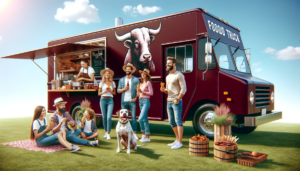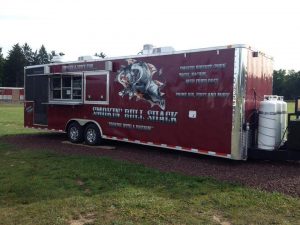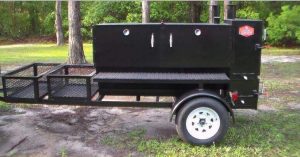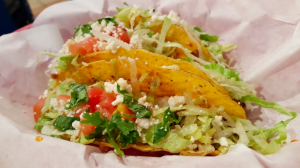In this blog post, we’ll guide you through the essential steps needed to start your own food truck business. From the initial planning and securing the right permits to choosing your menu and finding the perfect truck, each step is crucial for laying the foundation of a successful mobile eatery. We’ll also touch on the challenges you might face along the way and provide practical advice to navigate the bustling streets of the food truck industry.
Whether you’re a seasoned chef or a cooking enthusiast, these steps will help you bring your kitchen to the streets and make a mark in your city.
- Step 1: Concept and Market Research
- Step 2: Business Planning
- Step 3: Legal Requirements
- Step 4: Invest in a Food Truck or Concession Trailer
- Step 5: Kitchen and Suppliers
- Step 6: Location and Logistics
- Step 7: Marketing and Launch
Step 1: Concept and Market Research
Develop a Menu: What type of food will you serve? Are you aiming for gourmet burgers, vegan fare, ethnic specialties, or something else? In my opinion the best first step is to create the full menu you plan to serve. On a food truck, that usually means just putting together 5 – 8 really good items. After you get the menu figured out, the next step is to write out all the ingredients you’ll need to make them.
When developing a food truck concept, integrating timeless food items like burgers, tacos, and pizza with unique, contemporary spins can create a compelling menu that appeals to a broad audience while standing out in a competitive market. Here’s how you can think strategically about these timeless offerings by adding a creative spin.
- Burgers: Elevate this classic by using premium or locally-sourced meats, offering vegetarian or vegan alternatives like mushroom or black bean patties, and incorporating unique toppings inspired by global cuisines (e.g., kimchi, feta and olives, curry sauces).
- Tacos: Tacos offer incredible versatility and appeal. Experiment with non-traditional fillings such as Korean bulgogi, fusion flavors like Thai chicken with peanut sauce, or cater to health trends with keto-friendly and gluten-free options.
- Pizza: Introduce artisanal pizzas with unusual bases (like cauliflower or gluten-free options) and gourmet toppings (such as truffle oil, prosciutto, exotic cheeses). Offer a build-your-own-pizza experience to engage customers directly.
Market Research: Analyze the competition and potential customer base. Understand what’s already available in the area where you plan to operate and identify any gaps you could fill. The easiest way to do this is by searching the internet and seeing what the local landscape looks like. See if you can find any food truck concepts that aren’t operating in your area.

A busy BBQ food truck event.
Step 2: Business Planning
Write a Business Plan: The business plan should outline your business goals, operational details, and financial projections. Include your menu, pricing strategy, and marketing plan.
Budgeting: Consider startup costs (like the truck, kitchen equipment, initial food supplies) and ongoing expenses (fuel, maintenance, ingredients).
Budgeting is a critical component in the planning and operation of a food truck business, crucial for managing financial risks and ensuring profitability. Initially, startup costs must be considered, including the price of the truck itself, which can vary greatly depending on whether you opt to buy new, lease, or retrofit an older truck. This cost includes expenses for custom fabrication, painting, and branding. Additionally, outfitting the truck with the necessary kitchen equipment—such as cooking appliances, refrigeration, and storage units—requires investment in commercial-grade equipment that meets local health codes. Initial expenses also cover the purchase of enough food supplies to sustain operations for the first few weeks, accounting for both perishable and non-perishable goods.
Ongoing operational expenses form the second major category of budgeting. These include fuel costs for both driving and cooking, regular maintenance and occasional repairs of the vehicle and equipment, and the recurring costs of ingredients, which may vary in price. Labor costs are also significant, encompassing salaries or wages for staff, as well as benefits where applicable. Other regular expenses include insurance—covering liability, vehicle, and worker’s compensation—and marketing costs related to promotional materials, social media advertising, and event participation.
Step 3: Legal Requirements
Starting a food truck business involves navigating a variety of legal requirements to ensure compliance and protect your venture. Key steps include securing the necessary permits and licenses, as well as formally registering your business.
- Permits and Licenses: Check local regulations regarding food service businesses. You’ll likely need health department permits, a food handler’s license, and parking permits specific to the locations where you plan to operate.
- Business Registration: Register your business as a legal entity (like an LLC) to protect personal assets and comply with tax laws.

BBQ Trailer built by M&R Specialty Trailers and Trucks.
Step 4: Invest in a Food Truck or Concession Trailer
As an experienced food truck builder with more than 20 years of experience, we bring a wealth of knowledge to the table, helping you from the initial concept to the final rollout of your mobile eatery. Here’s how we can assist you specifically during these critical stages:
Choosing the Right Truck: I’ll work closely with you to understand your budget and business requirements, providing insights into whether a new or used truck will best meet your needs. Drawing on my knowledge of different truck models and their reliability, I can advise you on the best options that balance initial cost against long-term maintenance and operational efficiency. For instance, I can pinpoint which truck models have proven durable and which might require frequent repairs, helping you avoid costly downtime.
Customization and Branding: Once we’ve selected the perfect truck, I’ll guide you through customizing it to fit the specific needs of your menu. My approach includes designing a layout that optimizes workflow and space usage, such as strategically placing the grill and prep areas to maximize efficiency during peak hours. I’ll ensure that your kitchen is equipped with high-grade, commercial equipment that not only meets local health regulations but also withstands the rigors of daily food prep and cooking. For example, I can install energy-efficient refrigerators and stoves that are tailored to your cooking methods, whether you’re frying up tacos or baking artisanal pizzas.

Built by M&R Specialty Trailers and Trucks.
Step 5: Kitchen Equipment and Suppliers
Choosing the right food truck and its size is a crucial decision that hinges largely on the specific needs of your menu. The type of cuisine you plan to serve dictates not only the kitchen layout and equipment but also the power requirements and overall size of the truck. If you work with us this is something we will help guide you through during the consultation process. We want to make sure you have a truck that will be functional and fit your needs.
- Equip Your Kitchen: Based on your menu, choose the right equipment (grills, fryers, refrigerators). Ensure everything meets local health codes.
- Complex Menus Require Larger Trucks: If your menu includes a variety of dishes that require multiple cooking stations, such as a taco truck needing space for a griddle, deep fryer, and ample refrigeration for fresh ingredients, you’ll need a larger truck. These setups demand more counter space and storage to manage ingredients and cooked food efficiently.
- Simpler Menus Can Use Smaller Trucks: Conversely, a coffee truck, which primarily serves beverages, can operate efficiently within a smaller space. Equipment needs might be limited to coffee machines, a small refrigerator for milk and cream, and storage for cups and other small items.
- High-Power Equipment Needs: Trucks like those serving tacos or burgers typically require high-powered equipment such as griddles, fryers, and possibly even full stoves. These not only need more physical space but also substantial energy, usually necessitating larger generators or more frequent access to electrical hookups.
- Lower Energy Requirements: Coffee trucks, while they do require electricity for coffee machines and possibly small refrigerators, generally have lower energy requirements. This can be adequately managed with smaller generators or less frequent use of high-energy appliances.
- Food Preparation and Cleanliness: Trucks that prepare complex meals from scratch will need a more sophisticated setup with larger sinks for washing ingredients, more substantial wastewater storage, and enhanced ventilation systems to handle smoke and odors from cooking.
- Simpler Setup for Beverage Trucks: A truck that serves mostly beverages typically needs less elaborate water and ventilation systems. A basic setup with a single small sink for washing utensils and maintaining hygiene might suffice, along with minimal ventilation if most of the work involves only brewing and pouring drinks.
- Refrigeration and Dry Storage: A taco truck, which needs to store a variety of perishable goods, will require more extensive refrigeration capabilities and perhaps more significant dry storage areas for tortillas, seasonings, and other cooking essentials.

What will you be serving?
Step 6: Location and Logistics
- Scout Locations: Find spots where your target audience frequents. Consider foot traffic, the proximity of competitors, and local laws regarding food truck operations. One smart way to find potential vending locations is to track the vending locations of other food trucks on social media. If someone else is serving at a local brewery or farmer’s market there could be a way for you to get into that spot as well.
- Scheduling: Plan where and when your truck will operate. Regular spots and times can help build a loyal customer base. I suggest creating a Google doc that will allow you to write out a potential schedule for your truck. In general, Friday, Saturday, and Sunday will be your busy days. A lot of food truck owners decide to take Monday and Tuesday off.
Step 7: Marketing and Launch
A lot of food trucks spend most of their time identifying high traffic areas or events to serve at. These types of events have built-in grounds of hungry diners. If you serve a community long enough, you’ll be able to build a reputation and a following.
- Marketing Strategy: Use social media, local events, and word-of-mouth to promote your truck. Offer promotions or samples to attract customers.
- Grand Opening: Plan a launch event to create buzz. Consider partnering with local businesses or attending a food truck rally.
By carefully planning and executing these steps, you can set the foundation for a successful food truck business that not only serves great food but also turns a good profit. Remember, the key to success in the food truck business lies in combining culinary creativity with smart business strategies and operational efficiency.

Leave A Comment